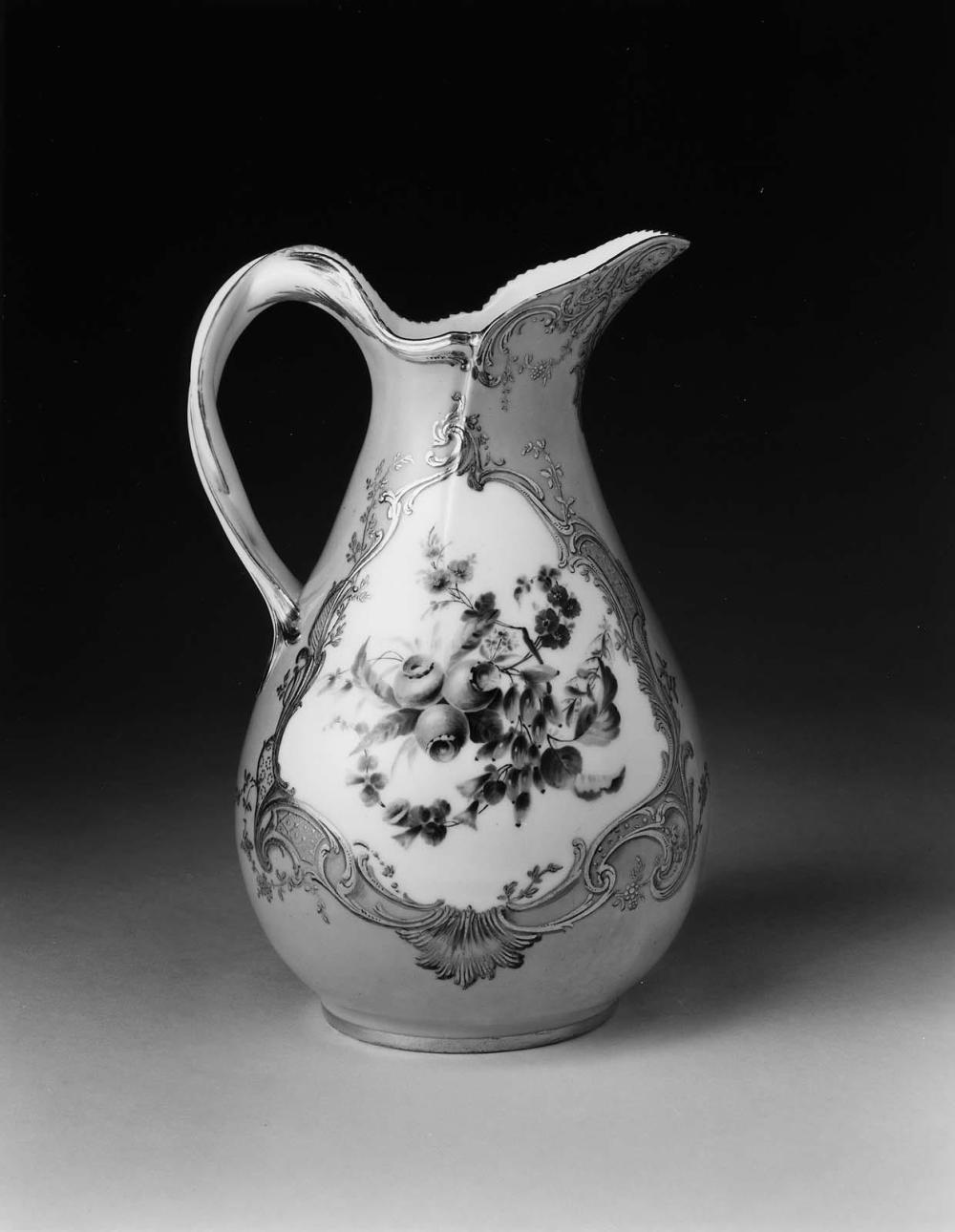Advanced Search
broc Roussel
Ewer
broc Roussel
Made at: Sèvres Manufactory (France)
Painted by: Philippe Parpette (active in 1755–1757, and 1773–1806)
Painted by: Philippe Parpette (active in 1755–1757, and 1773–1806)
French
1757–58
Medium/Technique
Soft-paste porcelain with colored enamel and gilded decoration
Dimensions
Overall: 19.2 x 12.6cm (7 9/16 x 4 15/16in.)
Other (Ewer (at base)): 7.3cm (2 7/8in.)
Other (Basin): 31.7 x 22.9 x 9.9cm (12 1/2 x 9 x 3 7/8in.)
Other (Ewer (at base)): 7.3cm (2 7/8in.)
Other (Basin): 31.7 x 22.9 x 9.9cm (12 1/2 x 9 x 3 7/8in.)
Credit Line
Gift of Rita and Frits Markus
Accession Number1982.173
CollectionsEurope
DescriptionThe ewer is pear-shaped, the narrow neck gracefully rising from the bulbous body to the flaring spout, which is balanced by the twisted handle springing from the undulating and slightly molded rim. The foliate lower terminals of the handle are symmetrically arranged. A faint mold line is evident around the widest part of the body, about 4.5 cm. (1 3/4 in.) above the base. The form of the basin is that of the more common jatte ovale, to which has been added a molded rim identical to that of the stand for the écuelle, no. 63. There is no piercing on this piece, however. The pink ground color is applied to the outside of the ewer, leaving two large reserved panels conforming to the shape of each side, and to the inside and outside of the basin, with eight reserved panels. On the basin, the upper side of the rim and the foot ring are also left white and are decorated with polychrome enamels and gold; there are two gold bands on the foot and gold banding and highlighting of the leafy scrolls and molding. The flowers in relief are painted in natural colors. The handle of the ewer is heightened with gold; there is a plain gold band at the foot and a gold rounded dentil band around the rim. The gilded ornament surrounding the reserves and, on the basin joining the reserves at the center, is treated with a liveliness and grace that echo the forms and the floral bouquets of the reserves. The gilding, which is partially burnished and slightly chased, is outlined or shaded with puce enamel to give the effect of a third dimension to the scrolling leaves, shells, and shaped panels; these are so thickly applied that they are actually in relief. The larger shaped panels at the center of the basin, the smaller ones under the spout, and those which form part of the framing of the reserves are decorated with a great variety of diapering, hatching, stippling, and other ornamental filling. The framing also includes leafy tendrils with flowers that twine around the sides and form swags at the bases of the reserve panels. The polychrome bouquets, or clusters, of flowers and fruits in the reserves also have the quality of swirling movement, with smaller leaves, berries, vines, and flower sprays looping and curling around the central grouping of larger flowers and fruits. Each of the arrangements is different, and all are painted with a delicacy of line, a liveliness of color, and a vibrancy of shading that equal the richness of the gilding and the ground.
Marks
on base of ewer:
(1) in blue enamel: inerlaced Ls enclosing date letter E above a script P
(2) incised: 4
(3) incised: R
on base of basin:
(4) in blue enamel: interlaced Ls enclosing date letter E above a script P
(5) incised: mLi
(1) in blue enamel: inerlaced Ls enclosing date letter E above a script P
(2) incised: 4
(3) incised: R
on base of basin:
(4) in blue enamel: interlaced Ls enclosing date letter E above a script P
(5) incised: mLi
ProvenanceNoailles family. By 1967, with Alfred Wenz, Paris. By 1967, Adolph Lion, Paris; November 7, 1967, probably sold by Adolph Lion to Frits Markus, Chatham, MA, and New York, NY; 1982, gift of Rita and Frits Markus. (Accession date: February 10, 1982)





